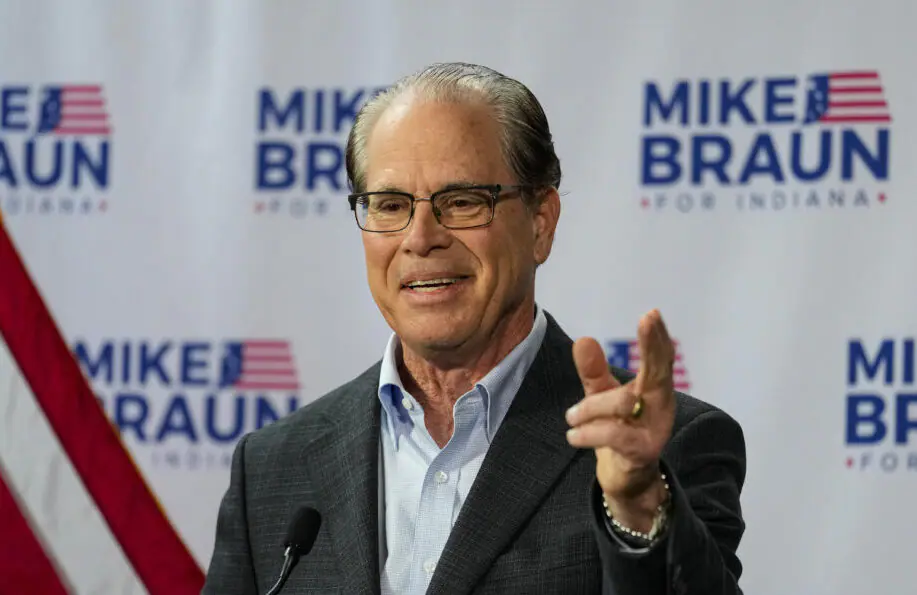Indiana doesn’t often see competitive primaries for governor. This year is different
INDIANAPOLIS (AP) — In a state as solidly Republican as Indiana, the May primary is the real competition.
Four months out, five candidates are still jockeying for the GOP gubernatorial nomination in an unusually crowded field. Annual campaign finance reports filed Wednesday reflect a multimillion-dollar race that has become a competition of who can out-conservative the others for primary votes in a state with historically low turnout.
Two-term Gov. Eric Holcomb, a Republican, cannot run again because of term limits. Indiana’s primary is May 7.
“In Indiana, we are not used to seeing competitive primaries,” said Gregory Shufeldt, a professor of political science at the University of Indianapolis.
Shufeldt said the crowded field could be a result of interest in state government roles, rather than a career in a Congress bogged with gridlock in the recent years. First-term U.S. Sen. Mike Braun’s decision to join the gubernatorial race opened up his seat, and many expect U.S. Rep Jim Banks, a Republican, to easily fill it.
Braun’s close allegiance to former President Donald Trump helped propel his Senate win in 2018 and has given him statewide name recognition. Braun ended 2023 with a healthy $4 million in the bank, according to finance reports, and has Trump’s endorsement again this year.
Touting similar name recognition is Lt. Gov. Suzanne Crouch, whose ambitious plan to eliminate the state income tax is one of the most divisive subjects in the race so far. “Axe the Tax” has been decried by the other candidates to some degree as unrealistic and untimely.
Holcomb has not endorsed a successor, including Crouch. And Crouch has rarely evoked Holcomb, whose popularity took a hit over some COVID-19 restrictions such as a statewide mask mandate. Crouch has, rather, relied on her record of statewide and county service and pitched a focus on mental health and addiction services.
Her campaign reported ending 2023 with $3.7 million in the bank.
Shufeldt called Crouch’s politics “pragmatic” conservatism, similar to Indiana’s past two governors.
“It’s a contest between conservative, very conservative and extremely conservative,” he said of the race.
Curtis Hill, the embattled former attorney general, has appealed to the Trump conservative base with his campaign rhetoric.
Hill lost the Republican nomination for reelection in 2020 following allegations that he drunkenly groped four women during a party. He denied the accusations, but the Indiana Supreme Court temporarily suspended his license after finding “by clear and convincing evidence that (Hill) committed the criminal act of battery” against three female legislative staffers and a state lawmaker.
He and Braun have been the most vocal on topics pertaining to issues contested in national elections, such as immigration and border security.
Shufeldt said Holcomb and former Gov. Mitchell Daniels, who served two terms before former Vice President Mike Pence, generally avoided stepping into “cultural issues” and focused more on school vouchers and economic development.
“I think a Braun or Hill governorship probably puts cultural issues more front and center,” he said.
However, Hill ended the year millions of dollars behind the competition, reporting about $123,000 in cash on hand.
The other Republican candidates, Brad Chambers and Eric Doden, have similar resumes. Both have led the Indiana Economic Development Corporation, a quasi-governmental agency, and have focused their campaigning on Indiana’s economic future.
Doden’s “Main Street Initiative” — focused on reviving and retaining the economy of Indiana’s small towns — is the backbone of his campaign. Chambers has repeatedly touted Indiana’s economic growth during his recent time as secretary of commerce. Both have directed messaging toward supporting law enforcement.
Chambers, who entered the race last of the bunch in August, raised over $8.5 million in 2023 and contributed $5 million himself. He ended the year with $2.91 million in the bank, according to records.
Doden threw his name in the ring as early as 2021 and reported over $1 million in cash on hand at the end of 2023. His campaign said he has raised $5 million to date.
While the race is expected to be the most expensive in Indiana history for the office, its unlikely to boost turnout, said Laura Wilson, professor of political science at the University of Indianapolis. Indiana historically has low voter turnout; 24% of those registered voted in the 2020 primary. Fundraising might matter the most to Doden and Chambers, who lack the name recognition of the other candidates.
On the Democratic side of the ballot, former Indiana schools Superintendent Jennifer McCormick is running a longshot bid to flip the state’s top office. McCormick split from the GOP over education policy and later changed her party affiliation after her term ended in early 2021. Libertarian Donald Rainwater and Republican Jamie Reitenour are also campaigning for the office.
Wilson expected the race to soon turn to more political topics including abortion and support for Trump.
“For some voters, I think, this race unfortunately is going to be somewhat of an afterthought because the focus nationally is going to be so heavy on the presidential,” Wilson said.
